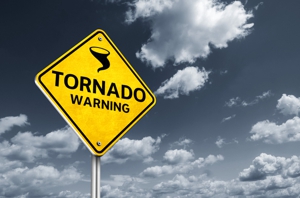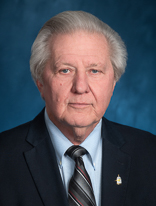Building Resilience, Saving Lives

Scott Cox sprinted across the field, slogging through ankle-deep water, to where his parents’ house stood moments before.
He found a mountain of debris from the EF5 tornado, a milk truck that the unusually powerful twister had flung into the yard, and his parents’ horse, bleeding, covered with welts, standing dazed near the remnants of the back deck.
And then Cox, a longtime member of the United Steelworkers (USW), heard his mother’s cries. He dug her out of the rubble by hand, saving her, only to lose his father, who was too injured even for CPR and perished along with 15 others in Smithville, Miss., that day.
The people of Smithville opened a domed tornado shelter following the April 2011 disaster, but that merely underscored America’s need for a comprehensive, forward-looking approach that empowers communities to fortify defenses, construct new bulwarks and avert climate-related destruction in the first place.
Now, thanks to President Joe Biden’s Infrastructure Investment and Jobs Act (IIJA), the nation is building that kind of lifesaving resilience.
The USW-backed IIJA delivers billions for projects to end droughts, protect the coasts against hurricanes, harden infrastructure, build stronger buildings, and provide grants for storm-resistant safe rooms.
Mississippi alone received hundreds of millions so far, including $4.8 million announced just this month to upgrade two hurricane evacuation routes.
“The ultimate responsibility of the government is to keep people safe,” observed Cox, president of Steelworkers Organization of Active Retirees (SOAR) Chapter 9-8. “That’s the No. 1 priority—and not only safe from enemies foreign and domestic but also from natural disasters.
“Having these resources, I think, is very, very important, especially in rural areas,” continued Cox, describing the Smithville disaster as a “traumatic experience that won’t end.”
Amid the tornado warning that day, he left the sporting goods factory where he worked to pick up his son at school. They arrived home in time for Cox to see the twister form as he stood on the front porch, and the two took shelter against the rain, wind, breaking glass and quaking walls.
After the tornado passed, Cox looked out the front door and saw that “everything that had been there my whole life” was “basically just gone.”
He ran across the family farm to his parents’ place, so damaged that he walked around wondering, “What part of the house is this?”
Cox discovered the milk truck, its wipers still squeaking back and forth in front of a hole that used to be the windshield, and he saw the driver, severely injured but still living, sprawled on the grass. He found his dad’s truck, “turned upside down and just crushed,” a hundred feet from the garage.
The horse stood near the area where Cox’s mother lay buried, and her cries guided him to the spot where he unearthed her and unsuccessfully attempted to save his dad. Cox’s son flagged down an ambulance, which transported his mother and the milk truck driver to the hospital just as other victims began arriving there, some stretched out on doors that had been shoved into the beds of pickup trucks.
“You can read about it,” Cox said of a natural disaster.
“You can watch it on TV. But unless you go through it, I don’t think you can totally understand how bad it is,” he added, noting the investments in resilience will spare others the pain he and his community experienced.
The need for these investments continues to grow as climate change contributes to stronger, more frequent storms as well as a growing number of floods, droughts and other disasters.
The IIJA, for example, invests hundreds of millions in federal, state and local programs for wildfire prevention and control. The funds cover initiatives ranging from remote fire detection to brush-clearing, forest thinning and other kinds of fuels reduction.
“Prevention is huge,” said Kevin Cadogan, a member of USW Local 9012 who steps away from his union paramedic job with Frontier Ambulance in Wyoming each summer to work as a wildland firefighter.
“We need to do a lot more fuels mitigation,” Cadogan said, noting some communities have little buffer between them and the forests. “We need enough space where we can slow the fire down before it gets to the house.”
Cadogan is a “hotshot,” an elite type of firefighter known for both skill and fitness who responds to wildfires throughout the United States and even Canada.
Because of the need for these firefighters, Local 9012 negotiated contract language enabling part-time paramedics like Cadogan to put in their required number of shifts before and after the fire season.
The IIJA also aims to build up and strengthen the firefighter corps. It funds training, furnishes equipment and provides health and safety resources, along with other supports firefighters need.
As part of a 20-person crew, Cadogan builds fire breaks and uses back fires, or controlled burns, to prevent and manage blazes. “It’s fighting fire with fire,” he said of the latter technique, noting controlled burns consume fuel the wildfires otherwise would use to gain strength.
Cadogan recalled arriving in Northern California two years ago to help fight the massive Mosquito Fire and seeing “the frightened look” in the eyes of residents evacuating one town.
He and his crew ended up helping to save the community, he said, calling it one of his most rewarding experiences as a firefighter.
Cox continues to heal from the Smithville tornado and knows that victims of other disasters bear similar scars. He applauds the IIJA investments because they deliver not only greater safety but peace of mind.
“When you take preventive measures like this, you really don’t know how many lives you can save,” he said. “It’s kind of like a good safety program in the plant. You just keep on keeping people safe.”


